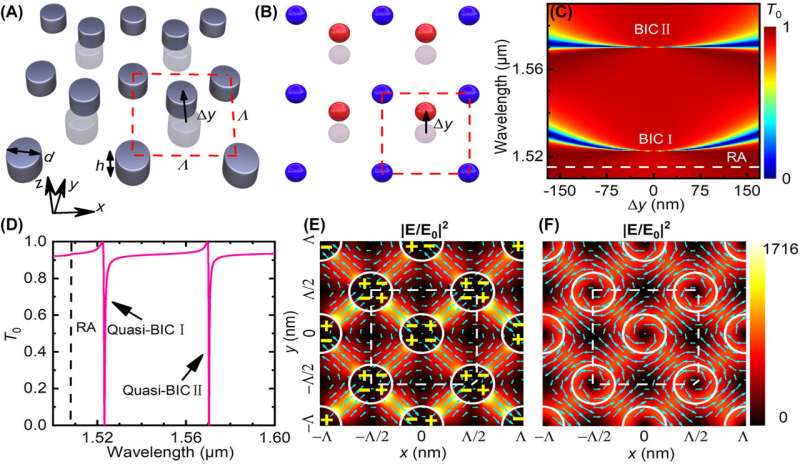Hybridization of surface lattice resonances induces dual-band bound states in continuum

In metasurfaces, surface lattice resonances (SLRs) and bound state in the continuum (BIC) are two convenient approaches for achieving high quality factors (Q-factors).
A research group led by Dr. Li Guangyuan from the Shenzhen Institute of Advanced Technology (SIAT) of the Chinese Academy of Sciences has revealed that hybridization of SLRs can result in dual-band BICs in silicon metasurfaces. The measured Q-factors can reach as high as 1240.
They also showed that the resonance wavelengths and Q-factors of the dual-band quasi-BICs can be conveniently tuned by varying the nanoparticle size or the lattice period.
This study was published in Nanophotonics on Nov. 1.
To date, most symmetry-protected BICs in periodic nanostructures rely on the structural symmetry breaking of the unit-cell nanoparticles. Reported approaches include asymmetrically-shaped nanoparticles, and bipartite nanoparticles with different sizes. In order to achieve high Q-factors for quasi-BICs, the structural asymmetry parameter should be tiny enough, posing challenges on the nanofabrication.
Size difference less than 10% is very challenging, especially when the nanoparticle diameter is only a few hundred of nanometers. However, the relative positions of nanoparticles can be accurately controlled in the top-down nanofabrication. "This motivated us to propose periodic bipartite nanoparticles with the central one slightly shifted from the center of the unit cell," said Dr. Li.
"To our surprise, the electric dipole SLRs (ED-SLRs) supported by two individual silicon lattices are totally canceled with each other in the bipartite arrays," said Dr. Li. "Instead, we observed dual-band BICs due to the hybridizations of two in-plane electric quadrupole SLRs (EQ-SLRs) and of two out-of-plane magnetic dipole SLRs (MD-SLRs) that are supported by the two individual silicon lattices."
The researchers also discussed the tunability and the potential applications. They found that the tunability of SLRs by varying the silicon nanodisks' diameter and the lattice period is inherited by the dual-band BICs.
"We hope this concept will help to suppress the inherent losses and to achieve high Q-factors for plasmonic metasurfaces," said Dr. Li.
More information: Xiang Du et al, Dual-band bound states in the continuum based on hybridization of surface lattice resonances, Nanophotonics (2022). DOI: 10.1515/nanoph-2022-0427
Provided by Chinese Academy of Sciences




















